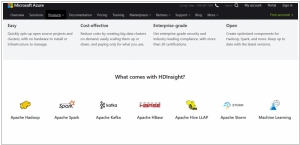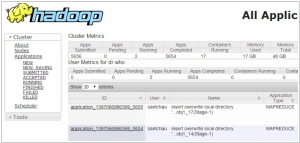Azure HDInsight vs Hadoop
March 17, 2025 | Author: Michael Stromann
7★
HDInsight is a Hadoop distribution powered by the cloud. This means HDInsight was architected to handle any amount of data, scaling from terabytes to petabytes on demand. You can spin up any number of nodes at anytime. We charge only for the compute and storage you actually use.
18★
The Apache Hadoop software library is a framework that allows for the distributed processing of large data sets across clusters of computers using simple programming models. It is designed to scale up from single servers to thousands of machines, each offering local computation and storage. Rather than rely on hardware to deliver high-availability, the library itself is designed to detect and handle failures at the application layer, so delivering a highly-available service on top of a cluster of computers, each of which may be prone to failures.
See also:
Top 10 Big Data platforms
Top 10 Big Data platforms
Azure HDInsight and Hadoop are like distant cousins in the vast, chaotic family of big data. Both are deeply fascinated by enormous amounts of data and spend their days attempting to organize it in the most methodical, efficient way possible. They thrive in distributed environments, handling anything from structured numbers to free-spirited, unstructured data, often teaming up with other frameworks like Spark, Hive and HBase to tackle their grand challenges. If there’s one thing they both agree on, it's that big data needs to be processed in parallel and that's exactly what they excel at.
But here’s the thing about Azure HDInsight: it’s the slick, corporate cousin who works for a cloud-based company. Launched in 2013 by Microsoft, it’s a fully managed service, meaning you don’t have to worry about pesky infrastructure issues. It’s happily integrated into the vast Azure ecosystem, which is a bit like a gigantic, all-encompassing, digital city where everything—yes, everything—works together. For those willing to pay for the convenience, HDInsight makes it easy to dabble in big data without ever having to touch a server. It’s made for those who prefer smooth, cloud-based simplicity over the murky waters of DIY data management.
Then, there’s Hadoop, the ancient, slightly scruffy open-source rebel who’s been around since 2006. It’s the one who insists on doing things on its own, if you’re willing to put in the time and effort to build and maintain everything yourself. Hadoop has no fancy cloud integrations; it’s much more of a hands-on, customize-it-yourself kind of guy. While it doesn't mind working with big companies, it doesn’t exactly hand-hold you through the process—so it’s perfect for those who have a strong will, a solid IT team and a taste for a more rugged, hands-on approach.
See also: Top 10 Big Data platforms
But here’s the thing about Azure HDInsight: it’s the slick, corporate cousin who works for a cloud-based company. Launched in 2013 by Microsoft, it’s a fully managed service, meaning you don’t have to worry about pesky infrastructure issues. It’s happily integrated into the vast Azure ecosystem, which is a bit like a gigantic, all-encompassing, digital city where everything—yes, everything—works together. For those willing to pay for the convenience, HDInsight makes it easy to dabble in big data without ever having to touch a server. It’s made for those who prefer smooth, cloud-based simplicity over the murky waters of DIY data management.
Then, there’s Hadoop, the ancient, slightly scruffy open-source rebel who’s been around since 2006. It’s the one who insists on doing things on its own, if you’re willing to put in the time and effort to build and maintain everything yourself. Hadoop has no fancy cloud integrations; it’s much more of a hands-on, customize-it-yourself kind of guy. While it doesn't mind working with big companies, it doesn’t exactly hand-hold you through the process—so it’s perfect for those who have a strong will, a solid IT team and a taste for a more rugged, hands-on approach.
See also: Top 10 Big Data platforms





